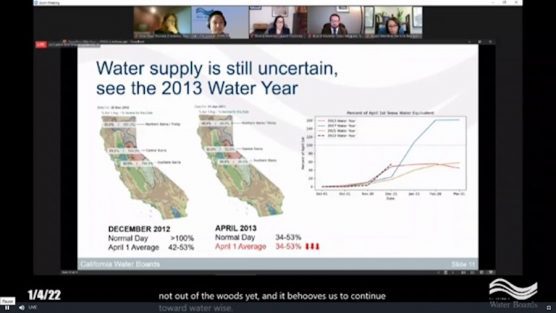By Nick Cahill
SACRAMENTO (CN) — Californians will again see water-wasting rules despite a record-breaking month of snow and rain as drought regulators on Tuesday barred residents from washing cars without a shutoff nozzle, watering lawns after rainfall or hosing down driveways and sidewalks.
Borrowing emergency rules implemented during the state’s previous historic drought, the State Water Resources Control Board said banning the wasteful practices is necessary to safeguard drinking water supplies. Though a historic amount of snow fell in parts of Northern California last month, many reservoirs remain lower than average and nearly 90% of the state is experiencing severe drought.
The water board said the goal of the “no-brainer” prohibitions — which carry fines of up to $500 per infraction — are to send a clear signal to California’s 40 million residents that the drought is nowhere near over.
“Regardless of how much precipitation we’ve had I think we all have gone through the sort of shock of how bad things were last year,” said Dorene D’Adamo, water board vice chair. “It’s important to continue to plan and assume that these great conditions we’ve had may not continue in the months ahead.”
California enacted similar rules in 2015 but they expired when then-Gov. Jerry Brown officially nixed the statewide drought declaration in late 2017. The latest set of temporary regulations approved unanimously on Tuesday will take effect by the end of the month and the restrictions are like those already adopted by many urban water suppliers.
Cities and municipal suppliers will be responsible for enforcing the rules, though several water board members mentioned no fines for water wasting were issued to residents under the previous drought emergency. Instead of households, the water board said potential fines are more likely to be levied against water suppliers or cities that shun the rules.
Water board member Sean Maguire acknowledged the timing of the rules following weeks of wet weather might seem a bit odd to Californians but reiterated there’s no guarantee more snow and rain is headed to the drought-riddled Golden State. He said the rules will hopefully serve as an important public awareness tool.
“These are just the practical, everyday things that we all can keep doing regardless of where we are in the state,” Maguire said.
The new rules make it temporarily illegal to:
– Water lawns and outdoor landscapes in a manner that causes “more than incidental runoff” onto sidewalks, roads or parking lots.
– Water outdoor landscapes within 48 hours of rainfall amounts of over a quarter-inch.
– Wash vehicles without a hose fitted with a shutoff nozzle.
– Use potable water to wash sidewalks, driveways, buildings, parking lots and other areas except for public health purposes.
– Use potable water for decorative fountains except those with pumps to recirculate water.
– Water public street medians or areas between the street and sidewalk.
– Bar homeowners associations from fining residents for not watering lawns during the drought
Meanwhile, Californians continue to miss the mark on Gov. Gavin Newsom’s call for a 15% cut in water usage by a wide margin.
Cities, businesses and households combined to slash water use by just 6.8% last November compared to a year ago. Since Newsom issued the voluntary order in July 2020, water consumption has dropped a cumulative 6%.
The latest monthly update was disappointing but not necessarily surprising: Californians traditionally turn off their sprinklers once the weather cools, leaving less room for conservation savings.
Some hydrologic areas of the state did meet Newsom’s goal, however, including the North Coast which reported a 26% savings, Sacramento River (24%), San Francisco Bay (20%) and San Joaquin River (17.5%).
Continuing to pull down the statewide average is the heavily populated South Coast region encompassing Los Angeles and San Diego, which increased its water usage compared to November 2020 by nearly 1%. Nearby Colorado River tallied just a 1% decrease.
The recent storms have improved the state’s drought outlook, particularly in Southern California, but many major reservoirs remain below their normal storage levels.
Shasta Lake, the state’s largest just north of Redding, stands at half its historic average and the second biggest, Lake Oroville, is faring better at 74% of average. Reservoir levels have improved drastically in smaller watersheds including Lake Mendocino, Folsom Lake and Pyramid Lake in Los Angeles County.
The rainy season is off to a fantastic start, but the commissioners reiterated the volatile nature of California’s climate means the skies could quickly turn dry in the coming weeks. Even after a booming December, the Sierra Nevada still needs to receive 30% of its historic total snowfall to break even. Long-range forecasts are predicting warm temperatures and below-average precipitation for most of the state.
The water board told a cautionary tale of December 2012, when the state received similar amounts of snowfall but by spring snowpack levels plummeted to below 50% of average.
“Despite all of the good weather we’ve had, of course we can’t assume that will continue to be the case,” said D’Adamo.
Like this:
Like Loading...
Related





 Tweet This
Tweet This Facebook
Facebook Digg This
Digg This Bookmark
Bookmark Stumble
Stumble RSS
RSS

























REAL NAMES ONLY: All posters must use their real individual or business name. This applies equally to Twitter account holders who use a nickname.
1 Comment
Rather than hold the 40 million residents of California responsible, why doesn’t some forward thinking politician (obviously not Newsome) propose desalinization plants along the Pacific ocean? We cannot “fine” or “conserve” our way out of water shortage.